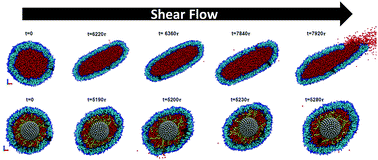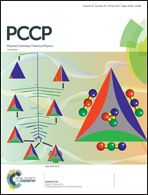Self-assembled core–polyethylene glycol–lipid shell nanoparticles demonstrate high stability in shear flow†
Abstract
A core–polyethylene glycol–lipid shell (CPLS) nanoparticle consists of an inorganic core coated with polyethylene glycol (PEG) polymers, surrounded by a lipid bilayer shell. It can be self-assembled from a PEGylated core with surface-tethered PEG chains, where all the distal ends are covalently bonded to lipid molecules. Upon adding free lipids, a complete lipid bilayer shell can be formed on the surface driven by the hydrophobic nature of lipid tails, leading to the formation of a CPLS nanoparticle. The stability of CPLS nanoparticles in shear flow has been systematically studied through large scale dissipative particle dynamics simulations. CPLS nanoparticles demonstrate higher stability and less deformation in shear flow, compared with lipid vesicles. Burst leakage of drug molecules inside lipid vesicles and CPLS NPs can be induced by the large pores at their tips. These pores are initiated by the maximum stress in the waist region. It further grows along with the tank-treading motion of vesicles or CPLS NPs in shear flow. However, due to the constraints applied by PEG polymers, CPLS NPs are less deformed than vesicles with comparable size under the same flow conditions. Thus, the less deformed CPLS NPs express a smaller maximum stress at waists, demonstrating higher stability. Pore formation at waists, evolving into large pores on vesicles, leads to the burst leakage of drug molecules and complete rupture of vesicles. In contrast, although similar drug leakage in CPLS nanoparticles can occur at high shear rates, pores initiated at moderate shear rates tend to be short-lived and close due to the constraints mediated by PEG polymers. This kind of ‘self-healing’ capability can be observed over a wide range of shear rates for CPLS nanoparticles. Our results suggest self-assembled CPLS nanoparticles to exhibit high stability during blood circulation without rapid drug leakage. These features make CPLS nanoparticles candidates for a promising drug delivery platform.



 Please wait while we load your content...
Please wait while we load your content...